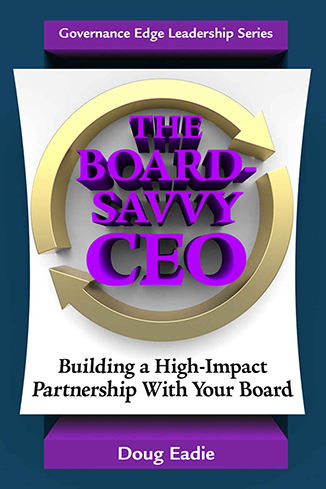I wish I’d had a copy of a new book I’m going to tell you about when, years ago, I was engaged in an agonizing personal struggle. Then a community college vice president, I’d become keenly aware that I did not have a passion for catching the 7a.m. train every morning to do day-in-day-out, nuts and bolts administrative work. Nor did I feel driven to become a public or nonprofit CEO. It’d become obvious to me that what I was truly meant to do was write books, consult and teach in the area of board and CEO leadership. Having a corner office and regular schedule didn’t resonate at all. But, despite my clear vision of the “good life,” professionally speaking, I was contending with tremendous angst that prolonged the decision making process a year beyond what it should have taken. In retrospect, it was a deep-down fear of failure that was keeping me in the proverbial “box,” sacrificing fulfillment for comfort. Risking failure at that point in my life was a fearsome prospect. Thank heaven vision and passion carried the day!
I was thinking about my experience last week during my flight to Richmond, Virginia to present a “board-savvy CEO” workshop. I’d just finished reading a really powerful little book that I wholeheartedly recommend and that I know you can put to work, in terms of both growing your CEO leadership capacity and leading change in your organization. But I’m pretty sure many of you reading this blog will find the title nerve-jangling: “Fail Fail Again Fail Better.” The author is an American Buddhist nun, Pema Chodron, and the foreword is by the well-known blogger Seth Godin.
As can-do Americans, many if not most of us find the idea of failing about as appealing as caressing a big hairy tarantula, and we naturally prefer not to focus on it. As Pema observes in her book, there is “a lot of emphasis on succeeding. And whether we buy the hype or not, we all want to succeed, especially if you consider success as ‘it works out the way I want it to.’ You know it feels good in the gut and in the heart because it worked out. So failing by that definition is that it didn’t work out the way you wanted it to.”
But when you reflect on business history and your own professional journey, it’s pretty difficult to ignore that fact that really high-stakes, high-impact innovation and change – the kind that can make a significant impact on your own professional effectiveness and on your organization’s long-term success – almost always involves some risk of failing. And if we kowtow to the avoid-risk-of-failure-at-all-cost demon, then the status quo will – once again – carry the day.
The challenge, it seems to me, is to pay close attention to calculating both the risk and potential cost of failing in particular situations. If you’re a CEO, there are risks you’d be foolhardy to take because of the potential damage that failing would do to the organization whose welfare is your responsibility. Just think of a public school superintendent who convinces her board to put a tax increase on the ballot without putting in place a meticulously designed campaign strategy. Or an association CEO who undertakes a reorganization of local chapters without making sure that a task force of chapter leaders is created to guide – and champion – the initiative.
Keep two things in mind. First, there are always plenty of risks involving failure that wouldn’t be devastating. To take a practical example, you might have your vice president for educational services pilot-test a new educational product – say, substituting a webinar for the traditional in-person workshop. Maybe the webinar will turn out to be a dud – doesn’t attract a critical mass of participants, or disappoints those who sign on. Either way, failure is quite bearable. And you can almost certainly tweak the webinar and risk more failure a few times without paying much of a price. Second, where the potential cost of failure is tremendous, you can focus on reducing the risk through meticulous planning and management.
Bottom line: Fail. Fail again. Fail better. But don’t be foolhardy. Make sure the likely cost of failure is bearable or that the risk of failure is containable. And don’t forget: discomfort and anxiety are always bearable costs!






